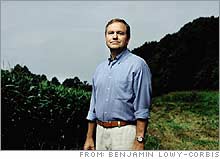|
Wal-Mart sees green The retailing giant is placing bets on an environmentally friendly future.
NEW YORK (Fortune) -- Wal-Mart has decided to help save the earth. Just listen to Lee Scott, the retailing giant's CEO. "To me," he says, "there can't be anything good about putting all these chemicals in the air. There can't be anything good about the smog you see in cities. There can't be anything good about putting chemicals in these rivers in Third World countries so that somebody can buy an item for less money in a developed country. Those things are just inherently wrong, whether you are an environmentalist or not."
Tell us what you think about Wal-Mart's environmental initiatives in an online forum. In a speech broadcast to all of Wal-Mart's facilities last November, Scott set several ambitious goals: Increase the efficiency of its vehicle fleet by 25 percent over the next three years, and double efficiency in ten years. Eliminate 30 percent of the energy used in stores. Reduce solid waste from U.S. stores by 25 percent in three years. (This is an excerpt from a story from the August 7th issue of Fortune, The Green Machine.) Wal-Mart (Charts) says it will invest $500 million in sustainability projects, and the company has done a lot more than draw up targets. It has quickly become, for instance, the biggest seller of organic milk and the biggest buyer of organic cotton in the world. It is working with suppliers to figure out ways to cut down on packaging and energy costs. It has opened two "green" supercenters. Plenty of people won't buy it - or anything else from Wal-Mart. To labor leaders, left-wing elites, and the small-is-beautiful crowd, the $312-billion-a-year retailer stands for everything that's wrong with big business. They see the company in a race to pave the planet and turn it into a giant emporium of cheap goods built on the back of cheap labor. The union-funded Web site walmartwatch.com dismisses Wal-Mart's environmental push as a "high-priced green-washing campaign." Wal-Mart, though, has a whole lot more to worry about than convincing a few ideological critics that its eco-intentions are pure. Its business, for starters. Its same-store sales growth has slowed, trailing Target's (Charts) and Costco's (Charts). Its stock price is another big concern. After rising 1,205 percent during the 1990s, the stock has fallen by 30 percent since Scott took over as CEO in January 2000. It's no wonder that inside Wal-Mart some veteran executives grouse that Scott's green crusade will be a costly distraction. Many remember the last time Wal-Mart set out an initiative this broad: founder Sam Walton's 1985 "Made in the U.S.A." campaign. That move burnished Wal-Mart's red-white-and-blue image, but it wasn't long before critics noted that Wal-Mart continued to seek out goods from the absolute lowest-cost supplier - and typically that meant "Made Anywhere but America." Indeed, Wal-Mart's single-minded desire to save its customers money has been its raison d'�tre for 44 years. So how does that square with its green conversion? A company under fire When Scott first took on the top job at Wal-Mart, he undertook a review of its legal and PR woes - and it wasn't a short list. A lawsuit alleging that Wal-Mart discriminated against its female employees had been certified as a federal class action. Opponents blocked new stores in the suburbs of Los Angeles, San Francisco, and Chicago. A study found that Wal-Mart's average spending on health benefits for its employees was 30 percent less than the average of its retail peers. The company's environmental record was nothing to boast about either: It had paid millions of dollars to state and federal regulators for violating air- and water-pollution laws. For years Wal-Mart simply brushed off such criticism. "We would put up the sandbags and get out the machine guns," Scott recalls. After all, business was good. They were saving their customers billions, fighting for the little guy. But as the upstart rural retailer grew into one of America's biggest companies and clashed with unionized competitors, it made powerful enemies. Expectations of business were rising, and Wal-Mart was failing to meet them. Scott wondered, "If we had known ten years ago what we know now, what would we have done differently that might have kept us out of some of these issues or would have enhanced our reputation? It seemed to me that ultimately many of the issues that had to do with the environment were going to wind up with people feeling like we had a greater responsibility than we were, at the time, accepting." So Wal-Mart spent nearly a year working with outside consultants to measure the company's environmental impact. Fairly quickly, they spotted waste that Wal-Mart's legendary cost cutters had overlooked. On Kid Connection, its private-label line of toys, for instance, Wal-Mart found that by eliminating excessive packaging, it could save $2.4 million a year in shipping costs, 3,800 trees, and one million barrels of oil. On its fleet of 7,200 trucks Wal-Mart determined it could save $26 million a year in fuel costs merely by installing auxiliary power units that enable the drivers to keep their cabs warm or cool during mandatory ten-hour breaks from the road. Before that, they'd let the truck engine idle all night, wasting fuel. Today that initial study has spawned 14 "sustainable value networks," made up of Wal-Mart executives, suppliers, environmental groups and regulators, each with a focus: facilities, internal operations, logistics, alternative fuels, packaging, chemicals, food and agriculture, electronics, textiles, forest products, jewelry, seafood, climate change and China. Experts from the World Wildlife Federation, the Natural Resources Defense Council, and even Greenpeace have made the pilgrimage to Bentonville. "I can honestly say I never expected to be at Wal-Mart's headquarters watching people do the Wal-Mart cheer," says John Hocevar, a Greenpeace campaigner. Getting tree-huggers and Wal-Mart lifers in the same room led to some unexpected benefits. "Sustainability helped us develop the skills to listen to people who criticize us and to change where it's appropriate," Scott says. His managers are learning "not to be so afraid of venturing out there, thinking that if people see our warts, they're just going to castigate us." It also gives them another reason to feel good about Wal-Mart, a sense of working for a "higher purpose," he says. The environmental campaign that Scott admits started out as a "defensive strategy" was, in his view, "turning out to be precisely the opposite." His people were feeling better about the company. They were saving their customers money. That was one of Wal-Mart's strengths. Another was twisting the arms of suppliers, which is why the impact of Wal-Mart's eco-initiative is potentially more world-changing than most big companies. Wal-Mart sells organic cotton, laundry soap, and light bulbs to millions. When shoppers see a display promoting "the bulb that pays for itself, again and again and again," they'll be reminded of their own environmental impact. By buying energy-efficient bulbs they'll also save money on their utility bills, leaving them more money to spend at, you guessed it, Wal-Mart. The bigger idea here is that poor and middle-income Americans are every bit as interested in buying green products as are the well-to-do, so long as they are affordable. Plenty of places sell fair-trade coffee, for example. Only Wal-Mart sells it for $4.71 a pound. "The potential here is to democratize the whole sustainability idea - not make it something that just the elites on the coasts do but something that small-town and middle America also embrace," says Conservation International's Glenn Prickett. "It's a Nixon-to-China moment." (This is an excerpt from a story from the August 7th issue of Fortune, The Green Machine.) ___________________________________ How America's biggest company became the world's biggest purchaser of organic cotton. Wal-Mart's unsentimental reasons for promoting sustainable fishing practices. |
|





